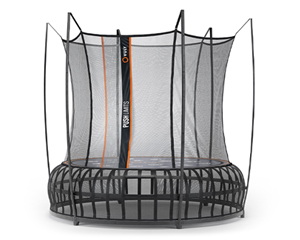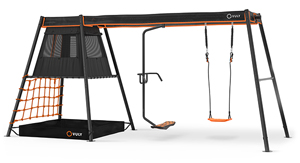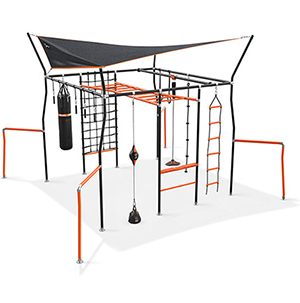
Jumping on a trampoline is a fun way to sneak some fitness into your lifestyle.
Over the recent years, the world of home fitness has seen a significant uptick in the popularity of trampoline exercises. As a fun and effective means to shape up, trampolining offers numerous key benefits for a full-body workout without being too harsh on the joints.
Nevertheless, despite the many advantages, it’s imperative to take stock of the risks that may be associated with trampoline exercises. For instance, there are over 100,000 trampoline-related injuries in the U.S. every year. That said, if safety measures, proper technique, and supervision are practised, then trampolining is still a safe option for people of various ages.
Let’s dive into the strengths and limitations of trampoline exercises to discover the answer to the question: Is jumping on a trampoline good exercise?
Pros of Trampoline Exercise
One of the most evident strengths of trampoline exercise is improving cardiovascular health. It gets your heart rate up while being joint-friendly. It also improves coordination, muscle strength, and weight loss.
1. Improves Cardiovascular Fitness
As mentioned above, trampoline jumping helps improve cardiovascular fitness. With the heart rate increasing to a certain degree, blood circulation improves. This type of exercise strengthens heart muscles and lowers the resting heart rate. This improves the capacity of the body to supply muscles with oxygen, making a positive impact on stamina and endurance in everyday activities. One of the other main benefits is that it reduces the risk of developing heart and blood vessel-related ailments.
2. Low Impact on Joints
You might’ve heard that running or jogging are two of the best types of cardio exercises. However, not many people are aware that running or jogging on pavement can negatively impact the joints due to the continuous impact. On the other hand, jumping on a trampoline produces fewer and more gradual forces on the body. This makes it an excellent alternative for individuals looking to mix up their routine with low-impact exercise.
3. Enhances Balance and Coordination
Using a trampoline requires maintaining stability on an unstable surface, which naturally promotes better balance and coordination. The constant adjustment helps to develop better motor skills and spatial awareness. These benefits are particularly valuable for children developing their physical abilities and for older adults aiming to maintain their agility.
4. Strengthens Muscles
Trampolines are great at strengthening leg and core muscles. With each jump, multiple muscle groups are engaged including the quads, calves, glutes and abdominal muscles. Depending on which specific jump is performed, it's possible to emphasise specific muscle groups. Trampoline jumping can provide a full body workout, better endurance and stronger muscles without the need for heavy weights.
5. Promotes Weight Loss and Metabolic Increase
Did you know that the high-intensity nature of trampoline workouts can do wonders in terms of promoting weight loss and enhancing metabolic rate? Every jump burns a substantial number of calories, making it effective for those aiming to shed extra pounds. Additionally, the metabolic boost from regular workouts can extend beyond exercise sessions, contributing to overall calorie burning and weight management. Summer physique, here we come!
6. Incorporates Fun and Variety into Your Workouts
It poses quite a challenge to commit to something that's boring. Trampoline exercise is inherently fun, adding a playful element to fitness routines. This enjoyment makes it easier to stay consistent with workouts.

Cons of Trampoline Exercise
While the pros are phenomenal, trampoline exercise still carries some significant drawbacks that must be considered. Injury risks, lack of general suitability, the necessity for proper technique, and space & equipment requirements are key points to take into account.
1. Injury Risks
Trampoline exercise can lead to injuries, especially if safety precautions are ignored.
Common injuries include sprains, fractures, and concussions. Younger children are particularly vulnerable to these potential hazards, as about 85% of trampoline injuries occur in those under 14.
Safety nets and pads are known to significantly reduce the risk of injury. Most trampoline injuries occur because people fall off the jumping mat, and so but preventing this, most injuries can be avoided by safety nets. Furthermore, proper supervision and limiting the number of people on the trampoline can reduce risks.
2. Not Suitable for Everyone
Unfortunately, trampoline exercise isn't suitable for everyone, particularly not for those with certain medical conditions or physical limitations such as pregnant women. Individuals with severe joint issues—such as arthritis—may find that trampolining worsens their pain. People suffering from heart conditions must also consult a doctor before attempting this activity.

3. Requires Proper Technique
Just like how you wouldn’t use a new appliance without reading the manual first, it pays to learn proper trampoline techniques before trying this type of exercise. This helps to reduce injuries and increase the effectiveness of your exercise routines.
Those who don't spend the time to learn proper technique often experience joint strain and muscle injuries. To maximize the benefits of trampoline exercises and minimize their risks, you’ll want to learn the correct form from a qualified instructor.
4. Space and Equipment Requirements
Trampolines require substantial space and trampoline accessories for safety and proper use.
Indoor trampolines call for high ceilings and ample floor space to prevent accidents. On the other hand, outdoor trampolines need a flat, debris-free area without any nearby obstacles like trees. To top it off, outdoor trampolines are often at the mercy of the elements - rain and wind can make working out difficult. Glaring sun can be avoided though by using trampoline shade covers .
How Trampoline Workouts Compare with Other Forms of Exercise
Intensity Levels Compared to Traditional Workouts
Trampoline exercise is generally high-intensity - you'll understand when you try it! After only a few minutes of bouncing, you'll be exhausted. It's also possible to do less intense, endurance workouts on a trampoline.
Bouncing can be easier on joints compared to running or high-intensity interval training (HIIT). This makes it suitable for individuals with joint concerns. Trampoline exercises for adults are at the right intensity to achieve cardiovascular, strength and weight loss benefits, with the intensity easily adjustable for different levels.
If you’re used to vigorous aerobic routines that significantly elevate your heart rate, then high-intensity rebounding is a great exercise regime.
Accessibility Compared to Gym Equipment
Trampolines aren’t that demanding type in terms of space and financial investment. Compared to most gym equipment, they’re typically more affordable—and you’ll find that they come in various sizes too.
A mini-trampoline is portable, can fit in a small room, and costs significantly less than treadmills or stationary bikes. This makes it an appealing option for home workouts. The large trampolines, on the other hand, open up more space to optimize your outdoor jumping escapades.

Engagement Levels Compared to Other Aerobic Activities
While most aerobic exercises can become monotonous over time, you’ll find that trampolines always bring a unique level of engagement and fun. Once you start bouncing, you'll never want to stop. You’ll find yourself motivated to maintain a dynamic fitness routine, learning new skills and trying new routines.
Let’s not forget the social element that trampolines bring to the table. Whether you’re attending group trampoline classes or bouncing with your family in the backyard, it’s bound to create fun memories and bonding moments.
Jump for Joy With Vuly Trampolines
Balancing the pros and cons of trampoline ownership, Vuly trampolines stand out by offering the best quality and safety. While the initial investment in durable frames and secure mats may be higher, the benefits far outweigh the costs.
For families looking to add a bounce to their backyard activities, Vuly trampolines are the clear choice.
Browse our trampoline collection today!
Explore our other blogs for more helpful tips:
-
The Psychology of Exercise: Why Bouncing Makes You Feel So Good
-
Benefits of Basketball – Is Shooting Basketball Good Exercise?























































